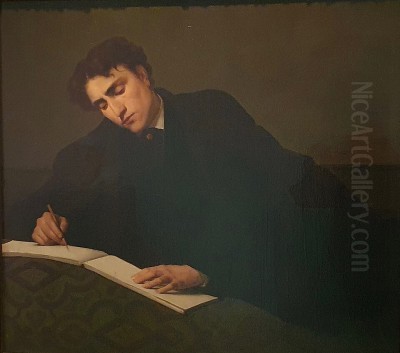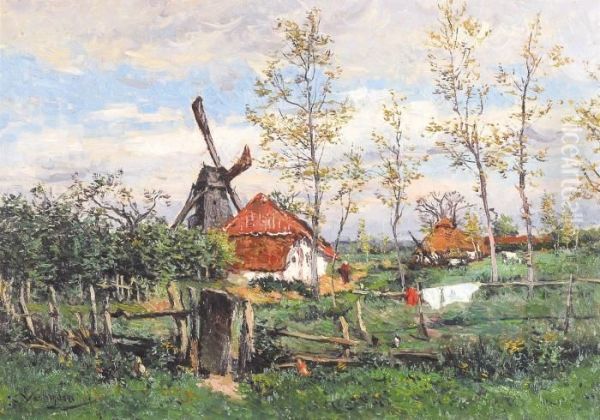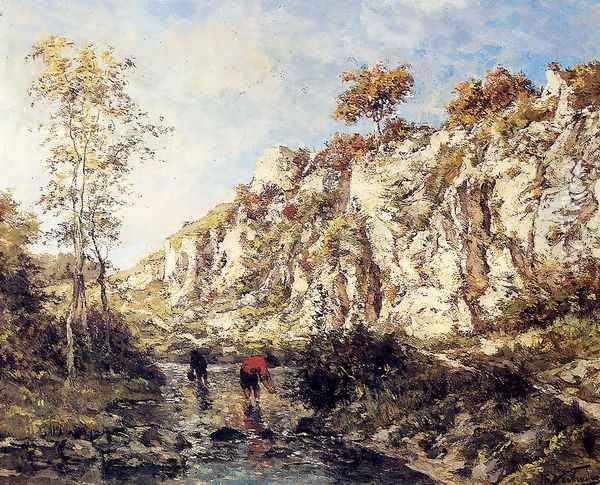
Isidore Verheyden stands as a significant figure in late 19th-century Belgian art. Born in Antwerp in 1846 and passing away in Brussels in 1905, his life spanned a period of intense artistic transformation across Europe. Verheyden navigated these changes, developing a distinctive style rooted in the strong Belgian realist tradition while embracing the revolutionary approaches to light and colour pioneered by Impressionism. Primarily celebrated as a landscape painter, he also excelled in portraiture and watercolour, leaving behind a body of work that captures the nuances of the Belgian environment and its people with sensitivity and technical skill. His journey reflects the broader artistic dialogues of his time, positioning him as both an inheritor of established practices and a participant in the avant-garde movements that reshaped European art.
Early Life and Artistic Formation
Isidore Verheyden's immersion in the art world began at birth. His father, François Théodore Verheyden, was himself a recognized painter, providing Isidore with an environment steeped in artistic practice from his earliest years. This familial connection to the arts undoubtedly shaped his path, offering both inspiration and perhaps an initial framework for his technical development. The Verheyden family's engagement with art was evidently deep; François Verheyden is known to have left behind a manuscript detailing recipes and techniques for painters and engravers, suggesting a serious, almost scholarly approach to the craft within the household.
Formal training commenced at the prestigious Académie Royale des Beaux-Arts in Brussels. This institution was a cornerstone of artistic education in Belgium, known for its rigorous curriculum grounded in academic principles. Here, Verheyden studied under notable figures who would have reinforced a solid technical foundation. Among his teachers were Joseph Quinaux (J. Quinaux), a landscape painter known for his Romantic yet realistic depictions of the Ardennes, and the influential Jean-François Portaels. Portaels, a director of the Academy, was a pivotal figure who encouraged individuality while maintaining high standards, having taught many artists who would define Belgian art in the latter half of the century. Verheyden's father also contributed to his formal education, blending familial guidance with academic instruction.

Verheyden continued to refine his skills through dedicated study between 1873 and 1883. This extended period of development suggests a meticulous and committed artist, constantly seeking to deepen his understanding and mastery. His early works from this formative period generally align with the prevailing realist tendencies in Belgium. They are often characterized by a more somber palette and a detailed, objective rendering of the subject matter, reflecting the influence of his training and the dominant artistic currents of the mid-19th century. This solid grounding in realism would remain a fundamental aspect of his art, even as he later explored more modern modes of expression.
The Strong Current of Belgian Realism
To fully appreciate Isidore Verheyden's artistic trajectory, it is essential to understand the powerful current of Realism that flowed through Belgian art during the mid-to-late 19th century. Unlike the often politically charged Realism of Gustave Courbet in France, Belgian Realism frequently focused on depicting the everyday lives of ordinary people, the specificities of local landscapes, and the social conditions of the time, often imbued with a sense of sobriety and empathy. Artists sought authenticity and truthfulness in their representations, moving away from the idealized subjects of Romanticism and Neoclassicism.
Key figures in Belgian Realism created a rich context for Verheyden's development. Constantin Meunier, initially a painter and later a renowned sculptor, captured the heroic dignity of industrial labourers and miners, bringing a profound social consciousness to his work. Charles Degroux depicted scenes of peasant life and urban poverty with poignant honesty. Henri de Braekeleer, working in Antwerp, focused on intimate interior scenes, rendered with meticulous detail and a subtle understanding of light and atmosphere, often evoking a sense of quiet melancholy. These artists, among others, established a national artistic identity grounded in direct observation and a commitment to representing contemporary reality.
Verheyden's early work clearly belongs to this tradition. His initial landscapes and portraits demonstrate a commitment to accurate depiction, careful composition, and a relatively subdued colour range. The emphasis was on capturing the tangible reality of the scene, whether it be the specific features of a sitter or the topographical details of a landscape. This realist foundation provided him with the technical discipline and observational skills that would underpin his entire oeuvre. It was a language he mastered before beginning to modify it with new influences.
Embracing Luminism and the Impressionist Palette

While firmly rooted in Realism, Isidore Verheyden's art did not remain static. As the 19th century progressed, new artistic ideas swept across Europe, most notably French Impressionism with its radical emphasis on capturing fleeting moments, the effects of light, and the use of pure, unmixed colour. While Verheyden never fully adopted the broken brushwork or dissolved forms characteristic of Claude Monet or Pierre-Auguste Renoir, he was clearly receptive to the Impressionists' fascination with light and atmosphere.
His style gradually evolved, moving away from the darker, heavier tones of his early realism towards a brighter, more luminous palette. This shift is particularly evident in his landscape paintings. He became increasingly interested in how light interacted with the natural world – how it filtered through trees, reflected off water, or illuminated the sky at different times of day. This focus on light effects aligns him with a tendency sometimes referred to as Belgian Luminism, a distinct national interpretation of Impressionist principles.
Belgian Luminism, exemplified by artists like Emile Claus, often combined Impressionist light sensitivity with a continued dedication to form and structure, sometimes retaining a more detailed rendering than their French counterparts. Claus, known as the 'painter of the sun', captured the vibrant light of the Leie region with dazzling intensity. Théo van Rysselberghe, another key figure associated with Les XX, experimented with Pointillism after encountering the work of Georges Seurat, demonstrating a scientific approach to colour and light. While Verheyden's approach was perhaps less systematic than Van Rysselberghe's Neo-Impressionism, he shared with these contemporaries a desire to infuse his canvases with a greater sense of air and radiance.
Verheyden's later landscapes show a freer application of paint and a more vibrant range of colours, used to convey the atmospheric conditions and the subjective experience of being in nature. He didn't abandon realism entirely; his subjects remained recognizable and grounded in observation. However, his interpretation became more personal and expressive, prioritizing the play of light and colour to evoke mood and sensation. This synthesis of realist structure and impressionist light became a hallmark of his mature style.
Subject Matter: Landscapes, Portraits, and Watercolours
Isidore Verheyden dedicated much of his career to landscape painting, finding endless inspiration in the Belgian countryside. His works often depict the forests, fields, rivers, and coastal areas of his homeland. He possessed a keen ability to capture the specific character of these locations, rendering the textures of bark, the density of foliage, and the movement of water with convincing naturalism. His connection to the tradition of landscape painting established by artists like his teacher Joseph Quinaux is evident, yet his later works infuse these scenes with a modern sensibility through their heightened attention to light.
His landscapes range from broad, panoramic views to more intimate woodland scenes. Works like Summer landscape with windmill likely showcase his ability to integrate man-made structures harmoniously within the natural environment, capturing the essence of rural Belgian life under the summer sun. Figures in a rocky stream suggests a focus on the interplay between human presence and the natural world, perhaps exploring themes of leisure or contemplation within a specific, observed setting. These titles point towards a commitment to depicting tangible places, often populated or marked by human activity, rendered with his evolving technique that balanced realistic detail with atmospheric effects.
Beyond landscapes, Verheyden was also an accomplished portrait painter. Portraiture demands a different set of skills – capturing not only a physical likeness but also the personality and inner life of the sitter. His realist training would have served him well here, providing the discipline needed for accurate drawing and modelling. While perhaps less numerous than his landscapes, his portraits were likely executed with the same careful observation and increasing sensitivity to light that characterized his other work. The source mentions Two Ladies on the Beach (1891), which, depending on its composition, could blend portraiture with genre or landscape elements, depicting figures within a specific coastal environment, a common theme in late 19th-century art explored by contemporaries like James Ensor or even international figures like Joaquín Sorolla.
Verheyden was also noted as a watercolourist. Watercolour, with its inherent transparency and fluidity, lends itself well to capturing fleeting effects of light and atmosphere. It requires a confident hand and a precise understanding of tonal values. His work in this medium likely complemented his oil painting, perhaps serving as a medium for preparatory studies or for finished works valued for their freshness and spontaneity. His proficiency across these different genres and media underscores his versatility and technical command.
A Pivotal Role in Les XX
Isidore Verheyden's significance extends beyond his individual artistic output; he was also an active participant in the Belgian avant-garde through his membership in the influential group Les XX (The Twenty). Founded in Brussels in 1883 by the lawyer and arts promoter Octave Maus, Les XX aimed to break free from the constraints of conservative artistic institutions and promote modern, innovative art from Belgium and abroad. For a decade, until its dissolution in 1893 (when it was succeeded by La Libre Esthétique), Les XX organized annual exhibitions that became crucial platforms for showcasing progressive art.
The membership of Les XX was diverse, encompassing a range of styles from Impressionism and Neo-Impressionism to Symbolism. Verheyden found himself alongside some of the most forward-thinking artists of the era. James Ensor, perhaps the most famous member, developed a highly personal and often macabre style. Fernand Khnopff became a leading figure of Belgian Symbolism, creating enigmatic and introspective works. Théo van Rysselberghe championed Neo-Impressionism in Belgium. Other members included Félicien Rops, known for his decadent and often controversial prints and drawings, and the talented painter Anna Boch, who notably purchased Van Gogh's 'Red Vineyard', the only painting he sold during his lifetime, at a Les XX exhibition.
Les XX was not limited to Belgian artists; it actively invited leading international figures to exhibit, fostering a vibrant cross-cultural dialogue. Auguste Rodin, Georges Seurat, Paul Signac, Camille Pissarro, Claude Monet, Paul Cézanne, and Vincent van Gogh were among the many foreign artists whose works were shown at Les XX exhibitions. This exposure to international trends undoubtedly influenced the Belgian members, including Verheyden, keeping them abreast of the latest developments in Paris and beyond.
Verheyden's participation in Les XX places him firmly within the Belgian avant-garde, even if his style remained more moderate compared to the radicalism of Ensor or the systematic approach of Van Rysselberghe. His presence in the group highlights his commitment to artistic renewal and his association with the progressive forces shaping Belgian art. His work, bridging realism and a personal form of luminism, would have contributed to the stylistic diversity that characterized the group's exhibitions, representing a thoughtful engagement with modernity grounded in strong traditional skills.
Teaching and Lasting Influence
Like many artists of his stature, Isidore Verheyden dedicated part of his career to teaching, passing on his knowledge and skills to the next generation. His position, likely associated with the Brussels Academy or perhaps through private instruction, allowed him to shape the development of younger artists. His most notable student mentioned in the source material is Anna Boch. Boch, herself a significant painter associated with Les XX and known for her Impressionist and later Luminist style, would have benefited from Verheyden's guidance, particularly his understanding of light and landscape. The teacher-student relationship between Verheyden and Boch underscores the interconnectedness of the Brussels art scene during this period.
Verheyden's influence likely extended beyond his direct pupils. As a respected painter and member of Les XX, his work was visible and contributed to the artistic discourse of the time. His particular blend of realism and luminism offered a model for artists seeking to modernize their style without completely abandoning traditional representation. He demonstrated a way to incorporate the lessons of Impressionism – particularly its emphasis on light and colour – into a framework that still valued solid drawing and composition. This approach may have resonated with Belgian artists who were perhaps less inclined towards the more radical experiments of French Impressionism or the burgeoning Symbolist movement led by figures like Jean Delville or Léon Frédéric.
His works found their place in important Belgian public collections, including museums in Antwerp, Brussels, and Ostend. This institutional recognition during or shortly after his lifetime confirms his standing within the Belgian art establishment. The presence of his paintings in these collections ensures their continued visibility and allows contemporary audiences to appreciate his contribution. His legacy lies in his sensitive depictions of the Belgian landscape, his skillful portraiture, and his role as a transitional figure who successfully navigated the complex artistic landscape of the late 19th century, bridging the gap between established realist traditions and the emerging aesthetics of modernism. Other contemporaries whose work might be considered in relation to Verheyden's milieu include landscape painters like Guillaume Vogels, known for his atmospheric and often moody depictions, and figure painters such as Eugène Laermans or George Minne, who explored different facets of Belgian life and symbolism.
Verheyden's Artistic Legacy
Isidore Verheyden occupies a respected place in the history of Belgian art. He was an artist deeply connected to his time and place, reflecting both the enduring strength of the national realist tradition and the transformative impact of Impressionist ideas. His artistic journey from a more somber, detailed realism to a brighter, more atmospheric luminism mirrors the broader evolution occurring in European painting during the late 19th century. He managed this transition with integrity, forging a personal style that retained a commitment to observed reality while embracing the expressive potential of light and colour.
His contributions as a landscape painter are particularly noteworthy. He captured the specific moods and textures of the Belgian environment with sensitivity and skill, creating works that resonate with a sense of place. His portraits, though perhaps less central to his reputation today, demonstrate his versatility and his ability to capture human character. His proficiency in watercolour further highlights his technical mastery across different media. Comparison with international contemporaries like Alfred Stevens (another Belgian who found fame in Paris) or perhaps even certain aspects of the Hague School in the nearby Netherlands might further illuminate his position.
His involvement with Les XX confirms his engagement with the avant-garde movements of his day. While not the most radical member, his participation signifies his alignment with progressive artistic forces and his role in the dynamic Brussels art scene that included artists ranging from the established Portaels to the revolutionary Ensor. His work provided a bridge, demonstrating how modern sensibilities could be integrated with traditional craftsmanship. As a teacher, notably to Anna Boch, he directly influenced the succeeding generation, ensuring the continuation of artistic dialogue and development.
Today, Isidore Verheyden is remembered as a key figure in Belgian art of the late 19th century. His paintings, found in major Belgian museums, offer a window onto the artistic concerns and aesthetic achievements of his era. He represents a thoughtful and skilled response to the challenges and opportunities presented by the shift towards modernism, creating a body of work that is both historically significant and enduringly appealing for its quiet beauty and technical assurance. His art stands as a testament to the rich and diverse artistic culture of Belgium during a period of profound change.